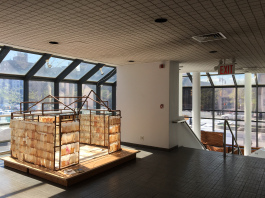The Bronx Museum of the Arts resides on the corner of 165th Street and Grand Concourse and is home to a wide variety of New York City and Bronx-related installations, sculptures, photographs and paintings.
One such example of this artwork is Bronx-based artist Michele Brody’s “Reflections in Tea.” The exhibit, which continues to evolve nine years after its introduction seeks to celebrate the worldwide ritual of making and drinking tea with a particularly communal focus.
Every Thursday in May, Brody and the Bronx Museum host CommuniTea, an interactive performance series in which museum visitors come together, enjoy tea and snacks and share stories with one another.
Afterwards, participants immortalize their stories, poetry and assorted musings through writing them down on the dried-out and flattened paper filters that were used to make the tea. “I think of tea as a time to relax and take a moment for myself. I don’t drink tea. What does that tell you about me?” reads one such filter. “Tea is the Bee’s Knees!” reads another. The filters are then assembled into tea-stained quilts of insightful, melancholic and funny reflections on relationships, work, solitude and of course, tea.
“Reflections in Tea” is only a small piece of what the Bronx Museum of the Arts has to offer. The modern building in which the museum is housed began as a public school, before its introduction as a division of The Metropolitan Museum of Art in 1971. The museum is now independent, and since 2011 has instituted a free-admission policy to all visitors in celebration of its 40th anniversary.
Hannah Max works at the museum and sees the various exhibits as a reflection of the neighborhood in which they are located. “We have kids coming in all the time asking to see the art,” says Max. “For the most part it’s local visitors.”
That being said, the Bronx Museum is no stranger to visitors from other parts of the city as well. “Either before or after Yankees games, we get a lot of people. I’m happy people are interested in both art and baseball, it gives me hope for the world,” said Max.
The influence of art is felt here on campus as well. “Being a visual arts student at Fordham provides the opportunity to learn in a city that has been home to some of the greatest artists and designers ever,” said Clare McGough, FCRH ’18, who is minoring in visual arts.
“Through every art class, I have the ability to learn from professors who are working to make a name for themselves among the great artists that this city has produced,” said McGough.
The Bronx Museum of the Arts displays exhibits from their permanent collection, such as “The South Bronx Trades,” a series of photographs by artist Martine Fougeron. Fougeron was born in Paris and currently lives in the South Bronx. Her collection seeks to highlight the wide variety of both past and present industries in the Port Morris and Hunts Point neighborhoods of the Bronx.
One photograph depicts a muscled, grim-faced man, his head turned towards the camera, unsmiling. His tattoos are partially concealed under a short sleeved, yellow shirt. In his hands, the man delicately holds a vase of pink flowers. The photograph, appropriately titled “The Flower Man,” demonstrates not only the enterprises in the Bronx that continue to thrive, but also the creeping influence of gentrification, according to Fougeron.
“I hope it [the Bronx] doesn’t move too far in the Williamsburg direction,” said Max, in response to the topic of gentrification in the borough. In fact, gentrification is a common theme among many of the exhibits at the Bronx Museum of the Arts.
One such example is painter Valeri Larko’s series, “Bronx Focus.” Larko’s paintings are an extremely realistic take on the evolving role of graffiti in Bronx culture. Her paintings depict a variety of dilapidated and rusted pieces of infrastructure in the Bronx that have been “tagged” with colorful murals.
Larko’s inspiration is rooted in her northern New Jersey upbringing, surrounded by graffiti-covered strip shopping malls and industrial parks. Today, Larko operates out of New Rochelle and concentrates most of her work in the Bronx, Brooklyn and Queens.
The Bronx Museum’s appreciation for art expands beyond sculpture, painting, and tea filters as well. The museum also hosts “First Fridays,” held on the first Friday of every month in collaboration with The Moth, a New York-based non-profit committed to the art of storytelling. Ten dollars will buy a general admission ticket, though the organization usually sets aside a number of complimentary tickets for Bronx residents. Ten featured storytellers are selected from a hat and have to present a five minute true story on a given topic. Next month’s theme is MAMA RULES! and will be held at the Bronx Museum on May 6.
On the first Wednesday of every month, the Bronx Museum also holds “Trolley Nights,” in which a decorated New York City trolley ferries tourists and Bronx residents to various historical sites along the Grand Concourse and surrounding areas. The program was first introduced in 2002 as the Bronx Culture Trolley and remains a popular attraction for both visitors and locals alike.
The Bronx Museum of the Arts’ outreach programs aim for far-reaching influence, but that does not mean that the effect of the classic galleries of photographs, paintings and sculpture is lost. “Aren’t these nice?” asked one visitor, gesturing to one of Valeri Larko’s “Bronx Focus” paintings. “All these are beautiful. What’s not to like?”





